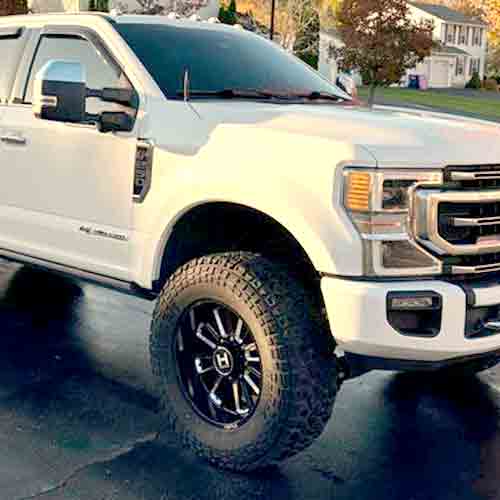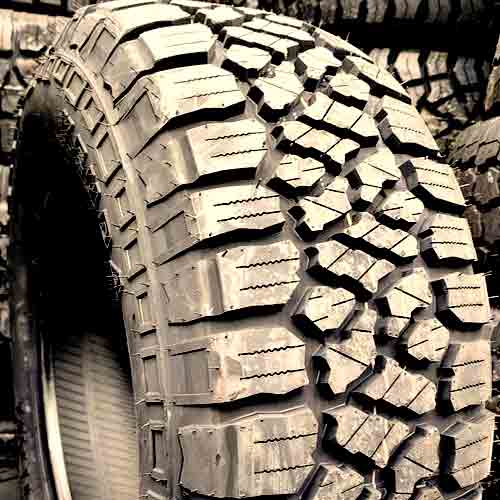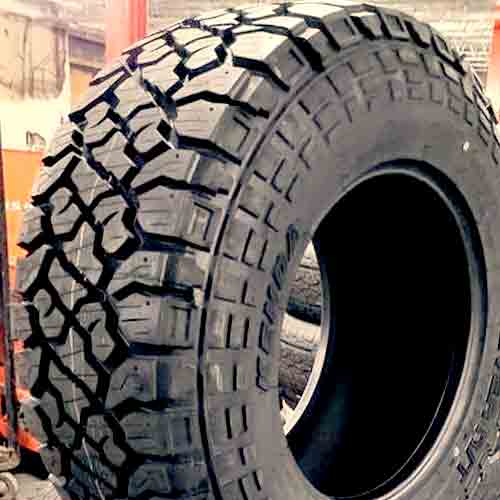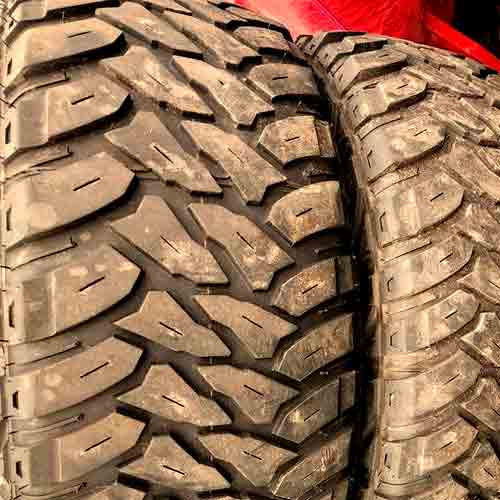Out of these, the Kenda Klever MT is made purely for off-road traction, whereas the A/T2 although also features rugged terrain performance, gets to offer a very decent on-road grip, handling and comfort performance as well. The Kenda R/T sits right in the middle of these two boys, and has a hybrid design. Let’s look at all of these Klever family members.

Sizes Specs
The Kenda Klever AT2 provides you with 15 to 20 inches rim diameters with following specs:
- Speed ratings: R, S, T and H.
- Load ratings: SL, XL, C and E.
- Weight range: 35 to 60 lbs.
- Tread depth: 14/32″ or 15/32″.
- Ratings: 3PMSF and M+S rated.
- Warranty: 50k (LT), and 60k for P metric sizes.
Review this tire in detail: https://tiredriver.com/kenda-klever-at2-review/
On the other hand, Kenda RT comes in total sizes of 33, where it offers between 15 to 24 inches (rim sizes). They have following specs.
- Speed rating: Q and R.
- Load rating: C to F.
- Weight: 40 to 80 lbs.
- Tread depth: Either 17 or 19/32″.
- Winter rating: Only M+S.
- Treadwear warranty: None.
Review this tire in detail: https://tiredriver.com/kenda-klever-rt-review/
The Kenda Klever MT comes in 15 to 22 inches with following.
- 22 total sizes.
- Speed ratings: Q on all.
- Load ratings: C, D and E only.
- Weight range: 50 to 88 lbs
- Tread depth: 19/32″, with only one size with 13/23″.
- Ratings: No 3PSMF.
- Warranty: None.
Tread Design
The Vietnamese tire, the Kenda Kelver AT2 provides you with the least aggressive tread design. Let’s check it out in more details.

In the middle you get very closely packed, smaller lugs (compared to its shoulders, I mean).
These are designed with full-depth rectilinear sipes, sharp edges, and offset sides, basically features that enhance performance across rugged terrains.
But the prowess of the AT2 isn’t limited to the wild outdoors. It also performs admirably on highways, thanks to the lugs’ close-knit layout providing ample rubber-road contact and embedded ridges which add stability.
(The lugs are connected to each other, and the connectors are the so called ridges here).
So these lugs are separated by wide circumferential grooves, beyond which are of course shoulder lugs, which are bigger blocks having interlocking sipes along with off-set edges and staggered outer margins.
Moreover, these lugs also join up with the sidewall lugs as you can see in the image above.
Moving ahead, the Kenda Klever RT comes right in the middle of two options and it’s tread pattern really shows.

The sidewalls of this tire feature sizeable lugs that cover significant real estate, thus increasing the overall tread footprint with lowered air pressure.
Moving towards the tread, you see staggered shoulder blocks where voids house stone ejectors (placed after every block).
Mroeover thse shoulder lugs are equipped with straight horizontal full-depth sipes and stud holes (for winter traction).
Moving towards the middle, the tread showcases four ribs creating X-shaped grooves, divided by broad circumferential channels.
Although not as wide as the outer grooves, these X-shaped voids are still impressive for a rugged terrain tire, as they offer admirable mud performance.
Moreover as these lugs carry ton of biters, you also get a great performance on other terrain types.
Though not as much as seen on the Kenda Klever M/T with is more aggressive tread design.

In the middle this tire’s tread consist of 2 ribs, featuring arrow shaped lugs.
These blocks have sharp off-set edges to them, and are equipped with deep siping slits, though they can get a little better.
Together these lugs make interconnected web of grooves connecting the outer more voided shoulders.
The shoulder blocks are very similar to the ones in the middle, though there aren’t as many edges to them.
And their outer margins are staggered, which is a norm when it comes to mud terrain tires.
Moreover, just like any other M/T, they have powerful sidewall biters to them as well.
Durability
The unpredictability and harshness of rugged environments demand exceptional resilience from off-road tires. But what measures how durable a tire is?
Well, through its internal construction.
And as expected, the Kenda Klever MT stands out in this aspect, as you get a robust internal structure here, that combines a 3-ply polyester cover with two steel belts, all reinforced by 2 nylon cap plies.
The Kenda RT also features 3 ply sides though, but its rubber on top, isn’t that thick. And Kenda AT2 lacks with just 2 ply sides.
Though the tire has similar steel belts and nylon cap plies on top.
Dry Capability
Evaluating an all-terrain tire’s performance on dry surfaces requires an in-depth assessment of two key factors: directional grip and cornering ability. Each of these aspects has its own subtleties, which we will now unravel for better understanding.
Dry Grip
Generally, tires with more voids, or ones which are considered “bald”, tend to struggle more with maintaining grip. So it makes sense why the Kenda Klever MT with its highly voided design, is the most lacking here.
In contrast, the Kenda Klever AT2, an all-terrain tire designed for versatile usage gives out pretty closed up lugs, allowing for great rubber to road contact.
Furthermore, these lugs are also connected to each other, and this features enhances the stability while braking, acceleration (mostly), improving directional grip.
On the other hand, the Kenda Klever R/T comes in between of two tires, in terms of performance, though surprisingly, our tests show that this tire only took 1 feet longer, coming to halt compared to its AT2 variant (dry braking test, which measures directional grip).
Though the Kenda MT took a lot more than that, showing up with least of all braking efficacy in our tests.
Handling
The effectiveness of a tire’s handling relies on the intricate balance between tread flexibility and shoulder lug design. And here the Kenda Klever AT2 emerges as an impressive performer.
Besides having a closed up design which offer best of all contact patch, all its lugs have reinforced foundations, so lugs stay in place as the tire corners, this allows for superior steering response.
On the other hand the Kenda RT and MT with a more flexible tread compounds and missing foundational supports exhibits more tendencies towards oversteering and understeering, as lugs bend a lot. And so you get very limited steering feedback.
Though as Kenda RT has smaller lateral tread voids, it’s still better compared to MT.
Muddy Trail Performance
In muddy conditions, you need tires having quick self-cleaning and effective scooping capabilities. And considering both the Kenda Klever MT, designed with a very voided structure stands out among its other family members.
With such gaps between the lugs, and their interlocked structure, the mud gets to have various pathways to leave out of the tread as soon as possible.
Moreover, with staggered shoulder having such huge mud scoops, the tire also shovels its way through the thick clay, throwing back the thick wet debris and creating forward momentum out of it, by Newton’s third law.
The Kenda R/T although features similar paddling efficacy with its equally as thick staggered shoulders, however, it still lacks to its M/T brother, due to its relatively closed up tread voids, not allowing mud to as effectively move out.
Though its still a lot better compared to Kenda AT2, which has a very crowded lug pattern.
Sand Traction
On sandy surfaces, tires need to float and paddle effectively, and once again, the Kenda Klever MT, despite being the heaviest variant, performs best due to its thick sidewall lugs.
These lugs basically expand out and allow for enhanced contact patch with the sand, allowing for great floating abilities.
Here, the Kenda Klever AT2 and R/T on the other hand although lack to MT, they give out equal performance values when compared to each other.
Here basically the Kenda AT2 lacks in providing as thick of the sidewall lugs, but still gets saved by it’s much lighter overall weight.
Rock Climbing Differences
Navigating rocky terrains is more than just a grip game; it’s about mastering multi-directional traction and donning an armor of resilient sidewalls, I learned this the hard way, sadly.
Having said that, the Kenda Klever M/T stands on top over its other family members here, with it’s 3 ply sidewalls having thicker rubber layer on top.
With this the tire basically take on more abuse compared to even R/T (which is also 3 ply sidewalls, but lacks in providing thick enough layer on top of that).
Moreover, the Kenda M/T also has thicker sidewall lugs too, so that further improves things for it. These lugs also get to offer enhanced traction with reduced air pressure, enhancing grip.
Speaking of which, the tire features thicker lugs, offering bigger groove mouth to bite on to the rocky surface form all “angles’, allowing for grip in both lateral and longitudinal directions.
The Kenda RT also does pretty well in this area, and is only lacking behind slightly. Though same can’t be said about the AT2, which falls short with smaller sidewall lugs and closed up tread voids everywhere in the middle, despite carrying good amount of biters.
Wet Traction
In case of wet performance, the overall performance really depends on the tread siping. And Kenda AT2 with the most number of sipes do best here.
Moreover, the tire also feature dual siping design, with rectilinear sipes in the middle, signalling for great braking performance, and interlocking ones on shoulder allowing for great handling capabilities.
In case of Kenda RT although the tire provides all weather rubber having a nice mixture of silica in it’s new gen tread, which provides its tread with needed stretchability. It still lacks to AT2 variant with its lacking sipes.
But still, its much better compared to MT.
It’s slits of sipes in comparison to that tire, offer a more flexibility and better wiping abilities.
The Kenda Mud Terrain, is least effective here, and its clearly shown by its tread with such limited number of sipes.
These sipes are also rectilinear so upon harsh braking and cornering, they tend to get further stiffer and loose water sucking efficacy (which is how sipes work).
Road Noise
Road noise arises from several sources, predominantly from the friction between the air and the treads, yielding three primary sound waves.
One is the whistling sound triggered by the inflow of air particles. The second is due to air particles hitting the tire’s walls, (where the impact makes the noise), and the third emerges from noise bouncing off the tread walls, leading to what is known as in-groove resonance, which is basically echoing of noise waves, you can say.
And all of these unwanted sounds are produced more on Kenda Klever MT.
The tire with such voided structure basically allows for air particles dance around every which way as they hit the tread walls with full force.
In comparison, the Kenda RT and AT2 do very well.
The RT variant with slightly smaller tread voids compared to MT gets to be slightly quieter, though not as quiet as the AT2.
And the AT2 with its impressive variable pitch technology performs the best here.
Fuel Consumption and Tread Longevity
The weight and stickiness of a tire’s tread significantly affect the fuel efficiency. And in this context, it is no surprise that the Kenda Klever AT2, with its lighter structure, stable lugs, and reduced gaps between, offers superior economy.
The benefits of such a design are evident: less energy is expended moving the tire, and less energy is wasted flexing, with more dedicated to rolling the tire.
In contrast, the heavier Kenda Klever RT and MT models require more energy to roll and are more prone to lug bending, leading to increased fuel consumption. Their heavier weight also increases pressure on the road, accelerating wear when coupled with a softer tread compound.
Consequently, it is understandable that the Kenda Klever MT and RT do not offer a tread life warranty, unlike the AT2 variant that offers 50,000 miles for LT sizes and 60,000 miles for P metric sizes.
Snow and Ice Traction
Progress in the development of all-season off-road tires has now reached a point where they offer reliable traction both during summer and on snowy terrains. Such tires are mostly branded with 3 peak mountain snowflake ratings.
And here the the Kenda Kelver AT2 gets to have that rating, thanks to its superb snow holding capabilities, especially when it comes to on-road snow.
So what is that and how it helps? Well let me explain.
Basically snow stick on other snow particles, much better than they do on rubber. So when lodged snow in the tread meets the snow on ground, it generates greater friction.
That’s why the Kenda AT2 with numerous tiny ‘biters’ that pick up snow, allow for better overall traction.
The Kenda R/T on the other hand, although does better than MT, can’t offer as much of a snow holding capability as its AT2 variant. Though the tire can be made better, as it gives you studable lugs.
And the Kenda Klever MT, on the other hand, with its larger voids, cannot retain snow at all when on road, although it performs well on deeper terrains by scooping and flinging mud backward to generate forward momentum.
To Sum Up
The Kenda Klever AT2 stands out for its superior on-road grip, handling, and steering response, owing to its less aggressive design. And other on-road features such as fuel efficiency, comfort, and tread life also lean in the AT2’s favor.
Interestingly, the Kenda Klever RT does really well in dry traction department, demonstrating amazing handling and braking efficacy, though still lacking a little bit to AT2, of course.
And off-road, both of these tires couldn’t match the performance of beast of a tire, the Kenda Klever MT.